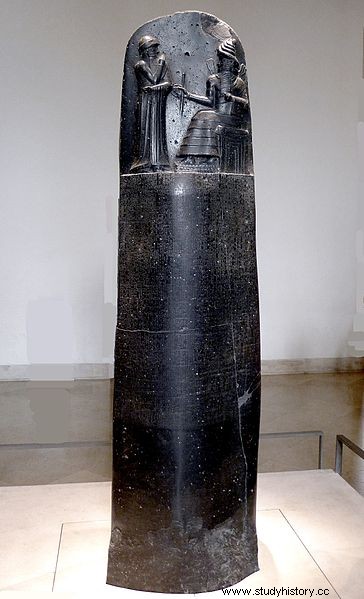Jacques de Morgan, a remarkable former engineer and Egyptologist, was appointed by the authorities in 1897 as director of the French archaeological delegation for excavations in Persia. Also, he undertakes to lead an expedition to this land of ancient civilizations and in particular to Susa. By digging into deeper layers than his predecessor, on the tell (accumulation of ruins) of the Acropolis, 30 meters high, he brings to light a forgotten dynasty, the Elam.
1901

Characters
Hammurabi
Procedure
During his excavations, the archaeologist discovered between December 1901 and January 1902 tablets, ceramics, statues, steles, including a very imposing one measuring 2.25 meters high and 79 cm wide, in basalt, on which are engraved inscriptions. This stele was found in two stages and in 3 pieces on the ruins of the Acropolis, near the sanctuary of Inshushinak, a local god. After transcription, it is the most complete and oldest text of laws in Mesopotamia which is in line with the codes of kings Urukagina (-2350), Ur-Nammu (-2100), and Eshnunna (-1800). ).
In addition to the prologue and the epilogue, 282 laws are written in cuneiform characters and in the Akkadian language, which reveal as much commercial, administrative, family or criminal law. We even find there the famous law of retaliation such as “if someone has gouged out the eye of a free man, we will gouge out his eye”. They were promulgated by the powerful king of Babylon, Hammurabi, founder of the powerful Babylonian empire, and engraved to his glory (around -1750). Indeed, on the stele is carved a bas-relief representing the sovereign receiving from the god Shamash, divinity of the sun and justice, the insignia of power (stick and circle). The deity thus dubs Hammurabi as the new god of Justice. Hammurabi appears as an all-powerful judge.
Different steles taking up this code of laws were thus spread throughout the kingdom in order to apply the legal authority and to recall the political sovereignty of Hammurabi. It is also with his posterity in mind that he had this code engraved since he had written in the epilogue of the stele "I annihilated the enemies in the North and in the South, I extinguished the fighting , I gave happiness to the country. […] __My auspicious shade is extended over my city; I hugged the people of the land of Sumer and Akkad to my bosom. This code also seems to be the testament of this aging king.
Consequences
This code sheds new light on the history of law. In addition, it is an invaluable source for knowledge of Babylonian culture at the political, economic, cultural or religious level. Indeed, concerning family law, we thus discover how this society dealt with divorces, marriage, inheritance, incest, or how important the presumption of innocence was, etc. This code of Hammurabi is therefore an invaluable testimony and allowed archaeologists to have a new look at Mesopotamian civilization.
